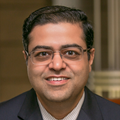Taking a Close Look at Atrial Fibrillation
 By Anurag Singh, MD, cardiac electrophysiologist, Premier Cardiovascular Institute
By Anurag Singh, MD, cardiac electrophysiologist, Premier Cardiovascular Institute
During my training in medical school, heart disease was almost synonymous with coronary artery disease. Coronary artery disease (CAD) was the predominant disease manifestation of any cardiac disease, which was mostly true. Over the last two decades, heart failure and cardiac rhythm abnormalities have now come to dominate the heart disease spectrum. In fact, in Australia, the No. 1 cause of all cardiac related admissions to hospitals is now cardiac arrhythmias, and the United States is fast catching up. Here I will discuss atrial fibrillation (Afib), which is currently the most common cardiac rhythm abnormality.
What is Atrial Fibrillation?
Afib is an irregular heart rhythm characterized by an absence of atrial activity on the EKG for more than 30 seconds and mostly associated with irregular ventricular rhythm; although ventricular rhythm can be regular if AV node disease/ pacemaker is present.
Why is it Important?
It is the most common heart rhythm disorder, affecting more than 5.5 million people in the United States alone. Afib increases a patient’s risk of stroke and heart failure and should be treated aggressively. Early diagnosis and treatment are important because Afib, like arthritis, is a progressive disease that becomes more severe over time.
Presenting Symptoms
More than a third of patients report no symptoms at all with Afib – which is dangerous, as the initial presentation in these cases is either stroke (five times increased risk) or heart failure symptoms, leading to more than 130,000 deaths annually. About one-third of patients report palpitations, while the rest report nothing more than fatigue and usually attribute it to their age, as Afib disproportionately affects the older population.
How to Diagnose
Diagnosis of Afib requires an EKG documentation of the episode. An event monitor, Holter monitoring, or recordings from a loop recorder/pacemaker are considered adequate documentation of an episode of Afib.
Risk Factors
Being over the age of 60, alcohol consumption, sleep apnea, hypertension, lung disease, thyroid disease, and coronary artery disease (CAD) are just a few risk factors for Afib. Inactivity and leading a sedentary life can also contribute to Afib; but interestingly, Afib risk is also increased in marathon runners – God’s way of telling us that everything should be done in moderation.
Treatment
Treatment of atrial fibrillation involves prevention of complications from atrial fibrillation and treatment of atrial fibrillation itself.
A risk score called the CHADS-VASC risk score is used to calculate the risk of a patient developing stroke. For a score of 2 or more, anticoagulation with warfarin or the novel oral anticoagulants (NOACs) is recommended.
Treatment of atrial fibrillation itself involves either rate controlling medications such as beta-blockers and calcium channel blockers, or rhythm controlling medications (also called anti-arrhythmic drugs or AAD) such as amiodarone, dofetilide, sotalol, etc.
Definitive treatment of atrial fibrillation involves catheter ablation. This can be done by cryoablation, during which a cold balloon is used to electrically isolate the pulmonary vein ostia from the rest of the atria; or radiofrequency ablation, in which a catheter tip is heated up using RF energy to damage the myocardium and prevent abnormal electrical impulses from escaping pulmonary vein ostia to the rest of the atria.
Recommendations from the American College of Cardiology
Afib ablation is now a Class 1A recommendation for treatment of Afib in patients who have failed anti-arrhythmic drug therapy, and a Class 2A recommendation for patients who do not want to take an AAD. After being informed of the potential side effects and drug interactions of AADs, most patients typically chose to proceed with ablation – a relatively safe procedure with a complication rate of only 2 to 3 percent.
Referral to a cardiac electrophysiologist directly from primary care physicians is becoming the norm for treatment of atrial fibrillation.
Back to the March 2022 issue of Premier Pulse

